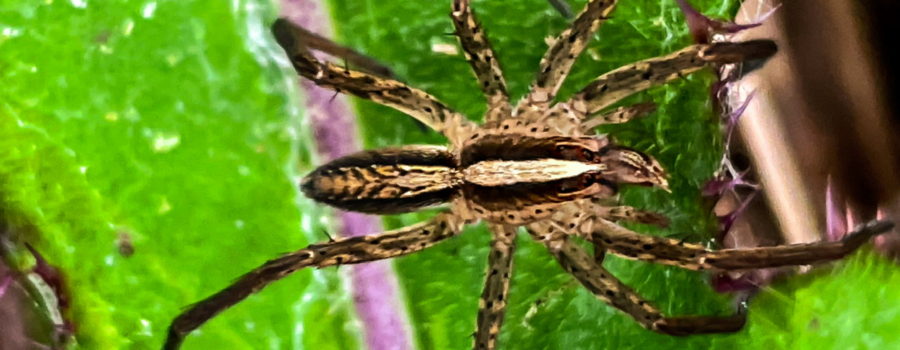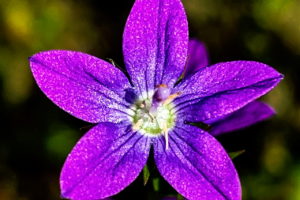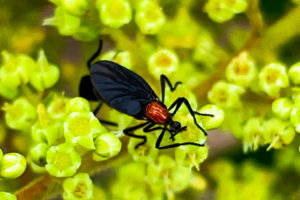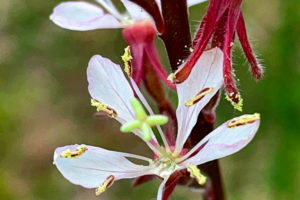Wolf Spiders Have Unique Eyes and Habits

Florida is known for it’s insects and spiders and to many people they’re truly frightening. I remember when our family first moved here my Dad would not allow us to go outside barefooted. He was sure that if we did, we would immediately be bitten by a poisonous snake or bitten by a large venomous spider. Needless to say, we do indeed have our fair share of venomous snakes and spiders, but most of our snakes and spiders are harmless, and in fact are important sources of natural pest control. One of these creatures is the wolf spider (family Lycosidae). Wolf spiders are incredibly adept hunters and can get quite large, so they have developed a bad reputation, but they’re actually great spiders to have around. And they’re not unique to Florida, either. Wolf spiders can be found in most of the world.
There are over one hundred genera of wolf spiders and thousands of different species. Obviously, not all of them occur everywhere, but multiple species often overlap in their ranges and wolf spiders of the same species may have several different color patterns, even within the same range. Individuals of a single species can also vary significantly in size, so the only way to accurately identify the genus and species of a wolf spider is to examine it’s genitalia microscopically, and requires a well trained entomologist. To make the identification process even more difficult, wolf spiders look very similar to grass spiders, fishing spiders, and nursery web spiders. The best way to tell all of these guys apart is by examining the pattern of the eyes. Wolf spiders have four small eyes in a row along the front of the head. Above that there are two large eyes, and then two medium sized eyes further back on their heads.

Wolf spiders tend to be solitary spiders that lead a wanderer’s lifestyle. Some types may defend a territory, but most of them move from place to place in search of mates and food. They are also don’t usually build webs, but instead they hunt by either stalking their prey or by hiding and jumping out onto unsuspecting victims similarly to jumping spiders and lynx spiders. Most wolf spiders are ground dwellers and live under leaf litter, small rocks, downed limbs and any place else that will conceal them from their prey and from their predators. This is also why most wolf spiders are blandly colored with patterns of brown, grey, black, and white. Most of them are also active both during the day, and at night. To help them see better at night wolf spiders have a tapetum lucidum, a reflective tissue in the back of the eye (it’s the same structure that makes dogs and cats eyes “glow” at night), in their four largest eyes.
Any of you who are familiar with wolf spiders have probably seen females carrying their egg sacks around under the ends of their abdomens. This is not a common habit, but there are several other types of spiders that also carry their eggs sacks including nursery web spiders and huntsman spiders. Most of these others, however, carry the eggs completely under the body while wolf spiders carry theirs on the spinarettes, requiring them to move with the back of the abdomen lifted up. You would think that this position would make hunting very difficult, but wolf spiders are quick and agile enough that they are still very effective hunters. The other spiders that carry their egg sacks do also tend to provide some care to the newly hatched spiderlings, but only wolf spiders carry the young on their backs. It is an odd looking spectacle when you find one of these females that are literally crawling with baby spiders!

The spider in these photos was found on the leaves of a thistle plant. I hadn’t even noticed the spider until it darted out from between two leaves to grab a fly. I watched it as it consumed the fly and as it wandered along the leaves, probably in search of more insects to eat. I was actually pleasantly surprised to find this spider out and about. It was a warm afternoon, but it had been cool at night. It was late afternoon and the sun was dropping quickly so I had actually been ready to head for home when I spotted the spider. I spent about 10 minutes watching it before it disappeared between two other leaves and was gone. Not at all a bad way to end my walk.
If you like beautiful nature photography and artwork along with interesting and engaging nature related content, then you will like this blog. Subscribe today and get each episode delivered directly to you.





Recent Comments